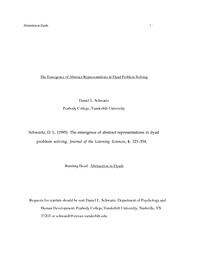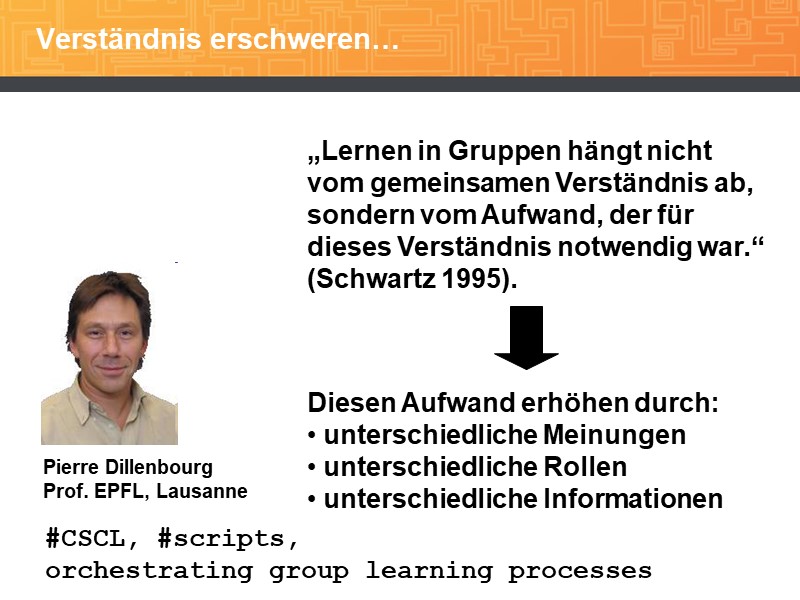The Emergence of Abstract Representations in Dyad Problem SolvingDaniel L. Schwartz
Erstpublikation in: Journal of the Learning Sciences, 4, 321-354.
Publikationsdatum:
|
 |
 Diese Seite wurde seit 2 Jahren inhaltlich nicht mehr aktualisiert.
Unter Umständen ist sie nicht mehr aktuell.
Diese Seite wurde seit 2 Jahren inhaltlich nicht mehr aktualisiert.
Unter Umständen ist sie nicht mehr aktuell.
 Zusammenfassungen
Zusammenfassungen
Three experiments examined whether group cognitions generate a product that is not easily
ascribed to the cognitions that similar individuals have working alone. In each study, secondary
school students solved novel problems either working as individuals or in two person groups
called dyads. An examination of their problem-solving representations demonstrated that the
dyads constructed abstractions well above the rate one would expect given a “most competent
member” model of group performance applied to the empirical rate of individual abstractions. In
the first experiment dyads induced a numerical parity rule for determining the motions of linked
gears four times more often than individuals, who instead tended to rely exclusively on modeling
the gears’ physical behaviors. In a second experiment requiring the construction of visualizations
on the topic of biological transmissions, dyads made abstract visualizations (e.g., directed graphs)
significantly more often than individuals. In a third experiment requiring a visualization of
organisms and their habitat requirements, dyads made abstract visualizations (e.g., matrices) five
times more often than individuals, who instead tended to draw pictures. These results are striking
because a long history of experimentation has found little evidence that group performances can
match the performances of the most competent individuals, let alone exceed them. The extremely
high frequency of abstract representations among dyads suggests that the abstract representations
emerged from collaborative cognitions not normally available to isolated individuals. The results
are interpreted to be a natural result of the collaborative task demand of creating a common
ground. To facilitate discourse dyads negotiated a common representation that could serve as a
touchstone for coordinating the members’ different perspectives on the problem. Because the
representation bridged multiple perspectives of the problem structure, it tended to be an
abstraction.
Von Daniel L. Schwartz im Text The Emergence of Abstract Representations in Dyad Problem Solving (1995)  Dieser Text erwähnt ...
Dieser Text erwähnt ...
 Personen KB IB clear | Idit Harel , Seymour Papert | ||||||||||||||||||
 Begriffe KB IB clear | Abstraktion
,  Einzelarbeit
, Emergenzemergence
, Einzelarbeit
, Emergenzemergence
,  Partnerarbeit
, Partnerarbeit
,  Problem Problem problem problem
| ||||||||||||||||||
 Bücher |
|
 Dieser Text erwähnt vermutlich nicht ...
Dieser Text erwähnt vermutlich nicht ... 
 Nicht erwähnte Begriffe | Gruppenarbeit |
 Tagcloud
Tagcloud
 2 Vorträge von Beat mit Bezug
2 Vorträge von Beat mit Bezug
 Zitationsgraph
Zitationsgraph
 Zitationsgraph (Beta-Test mit vis.js)
Zitationsgraph (Beta-Test mit vis.js)
 7 Erwähnungen
7 Erwähnungen 
- Collaborative Learning - Cognitive and Computational Approaches (Pierre Dillenbourg) (1999)
- Three worlds of CSCL - Can we support CSCL (Paul A. Kirschner) (2002)
- Over-scripting CSCL - The risks of blending collaborative learning with instructional design (Pierre Dillenbourg)


- Over-scripting CSCL - The risks of blending collaborative learning with instructional design (Pierre Dillenbourg)
- What we know about CSCL and implementing it in higher education (Jan-Willem Strijbos, Paul A. Kirschner, Rob L. Martens) (2004)

- Instructional support in CSCL (Sanna Järvelä, Päivi Häkkinen, Maarit Arvaja, Piritta Leinonen)
- A framework for integrated learning scripts - Deliverable 23.4.1 (Pierre Dillenbourg, Patrick Jermann, Armin Weinberger, Karsten Stegmann, Frank Fischer) (2004)


- The mechanics of CSCL macro scripts (Pierre Dillenbourg, Fabrice Hong) (2008)


- CSCL 2009 (2009)

- Thinking with Diagrams - The Semiotic Basis of Human Cognition (Sybille Krämer, Christina Ljungberg) (2016)

 Volltext dieses Dokuments
Volltext dieses Dokuments
 |  The Emergence of Abstract Representations in Dyad Problem Solving: Artikel als Volltext ( The Emergence of Abstract Representations in Dyad Problem Solving: Artikel als Volltext ( : :  , 4360 kByte; , 4360 kByte;  : :  Link unterbrochen? Letzte Überprüfung: 2020-11-28 Letzte erfolgreiche Überprüfung: 2017-05-05) Link unterbrochen? Letzte Überprüfung: 2020-11-28 Letzte erfolgreiche Überprüfung: 2017-05-05) |
 Anderswo suchen
Anderswo suchen 
 Beat und dieser Text
Beat und dieser Text
Beat hat Dieser Text während seiner Zeit am Institut für Medien und Schule (IMS) ins Biblionetz aufgenommen. Beat besitzt kein physisches, aber ein digitales Exemplar. Eine digitale Version ist auf dem Internet verfügbar (s.o.). Aufgrund der wenigen Einträge im Biblionetz scheint er es nicht wirklich gelesen zu haben. Es gibt bisher auch nur wenige Objekte im Biblionetz, die dieses Werk zitieren. Beat hat Dieser Text auch schon in Vorträgen erwähnt.












 Biblionetz-History
Biblionetz-History